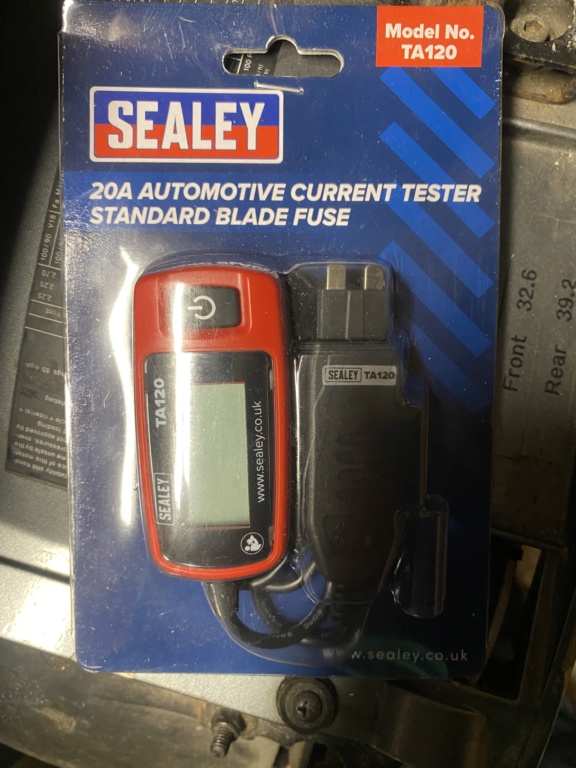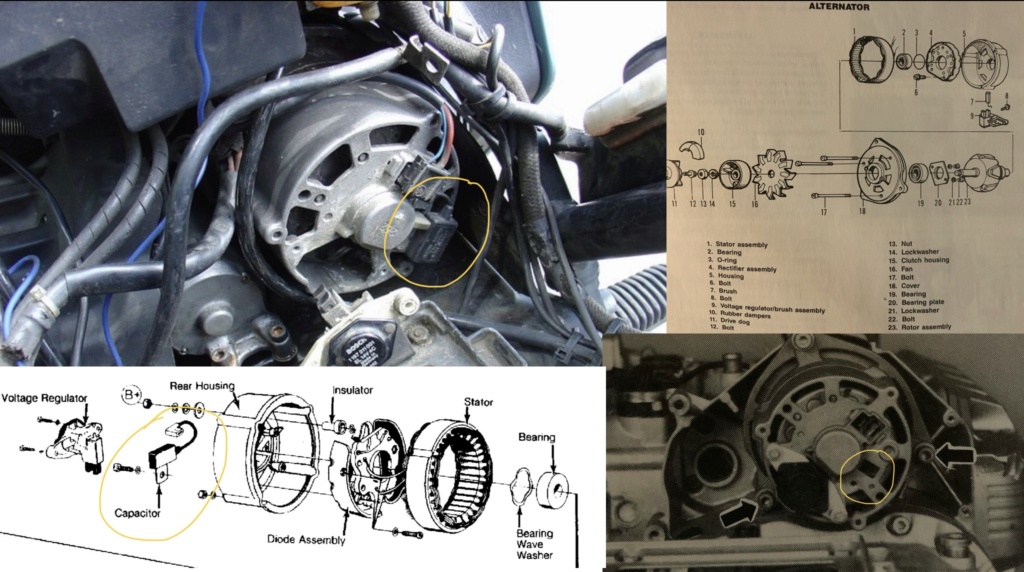1

 Battery woes - solved Mon Mar 18, 2024 7:07 am
Battery woes - solved Mon Mar 18, 2024 7:07 am
Born Again Eccentric
Life time member

As part of putting ‘Heidi’ back on the road after her 4 year rest, she has been stripped down and rebuilt (engine removed from frame level of strip down). Amongst other things, she was treated to a new 30AH Motobatt AGM battery and I replaced my alternator with a shiny spare one I had.
Battery fully charged before connection…a bit of cranking to get fuel though (tank, fuel pump, injectors etc had all been off during the refurb) and engine fired up. Voltmeter showed Alternator kicking out 13V+ and 14V+ when revs increased to 2000rpm. All looked good and she was running sweetly on a short test ride. ABS brain successfully reset.
Imagine my surprise the following day when went to start again and there was nothing doing. Checked battery volts - it had dropped to 6.5V. Bugger! Battery disconnected and recharged. Happily, it held 12.9V when disconnected. Hopefully no damage done.
So…electrical investigation ensued. What was flattening the brand new battery so quickly, with ignition off?
First things first, a forum search…some good testing advice found and bought myself one of these gizmos from Amazon…(thanks for the suggestion Side Car Paul & Arby)


Tested each fuse position in turn. With ignition off, the only current draw was max 0.02A which I associated with the clock (20mA is a bit high though). I have a few separately fused auxiliary circuits I have added (only live when ignition on) - things like gps, fan override and rear fog light. They all showed 0A draw.
Disconnected battery positive terminal and connected my Fluke 179 test meter between battery and positive wires…first on 10A range and then on 400mA range. Fluke showed 0.01A…however, missed the clue that the clock was off and totally puzzled how 0.02/0.01A could be draining a 30Ah battery in 12h. Discovered later that both the 11A and 400mA fuses in the Fluke had blown, hence no current flow, no clock indication and a spurious 0.01A reading.
Much pawing over the forum tech page electrical diagrams, particularly the battery flat version which shows the permanently live (unfused) components. ABS doesn’t seem to be shown, but RickG comment in one of my searches suggested that the ABS brain can develop a fault that cause battery drain. I believe in easy first. ABS Brain disconnected and, with fully recharged battery connected, I waited and monitored battery voltage which continued to steadily fall over next 6 hours. Incidentally, RickG had said his fault was associated with an ABS fault #7 tasting was hard to clear. Mine had had a fault #4 (rear sensor) which I had replaced and successfully cleared the fault.
Side fairing and fuel tank off. Next check was the relays…had one of those welded on and drawing current? All relays checked out ok. I can just get to the relays by lifting the rear of the tank, but it is awkward, so easier to pop the tank off.
More pawing over the electrical diagrams and scratching of my head. More checking of currents with plug in ammeter and Fluke. This is when I realised the clock wasn’t working with the Fluke in circuit. Checked Fluke fuses - both blown. Spares ordered from Amazon (£11 for two fuses
Spares ordered from Amazon (£11 for two fuses  ) and battery recharged while waiting for the next day delivery.
) and battery recharged while waiting for the next day delivery.
While waiting, cleaned up ignition switch and checked with Fluke (only the ammeter function wasn’t working). No problem with ignition switch.
Starting to think my new motobatt was the problem…charges ok but lacking capacity. At an eye watering £145 (motorworks) it was going to go back, if that was the case. Easy way to check for sure. New battery removed from Heidi and swapped with Gretel’s older motobatt. Both batteries connected and went out for a long walk in the Spring sunshine, feeling quite confident that I had sussed out the problem.
9.5 miles and a few hours later…voltmeter on Gretel (new battery) - no voltage drop from initial readings. Voltmeter on Heidi (older battery) - voltage had dropped. Agggghhhhhh!!!!!! So, diagnosis is the new motobatt is not defective and there is definely a fault somewhere on Heidi’s circuits. Put the new motobatt back on Heidi and let Gretel have her old, but fully functional, battery back.
More pawing over the electrical circuit diagrams. New fuses in my Fluke and put it into circuit as ammeter. Aha moment, detected a current draw of 2A (2A drain on a 30Ah battery…ties in with battery discharging in about 12h).
Started rummaging in the nest of wires and plugs under the tank. Earth connections rechecked. All wires disconnected in turn (there are a lot of them) while watching the ammeter. Nothing found. After market ‘Oxford’ heated grips do have a permanently live supply to their control unit (only draws current when turned on) and no impact on ammeter reading when unplugged.
Final check…unplugged alternator. Bingo - ammeter reading dropped to 0.01A. Plugged back in, 2A, disconnected 0.01A. Found the issue at last! Checked voltage at alternator plug. Red wire 12.8V Blue wire 0V (ignition off), both 12.8V with ignition on. Removed alternator voltage regulator and replaced with one from old alternator. Rechecked with ammeter…still 2A…so fault lies within the alternator itself. Reassembled old alternator, with its original voltage regulator. Refitted to Heidi, plugged in and checked current with ammeter…0.01A current draw. Fuel tank back on (temporarily), engine fired up, alternator outputting correct voltages.
Recorded battery voltage with everything connected. 12h later, rechecked and voltage has remained at 12.8V. Now to put the bike back together and get her MoT’d. What a saga…particularly as there was no need for me to change the alternator in the first place…it just seemed like a good idea as I had a shiny (second hand ) spare and why not while the bike was in any pieces? Now I know why not…the old adage. “If it ain’t broken, don’t fix it!”
It was a long slog getting to the root of the problem. As with all things electrical, the investigation needs to be methodical and the test equipment needs to be working! Moral of that story - check all indication (e.g. clock, in this case). Unless you’re lucky, it takes a lot of time to find the fault. In slower time, I’m going to pull the defective alternator apart and find out why.
Once again, the K100 forum and its search function, proved invaluable to me. Hopefully, this post will help someone else in the future.

Battery fully charged before connection…a bit of cranking to get fuel though (tank, fuel pump, injectors etc had all been off during the refurb) and engine fired up. Voltmeter showed Alternator kicking out 13V+ and 14V+ when revs increased to 2000rpm. All looked good and she was running sweetly on a short test ride. ABS brain successfully reset.
Imagine my surprise the following day when went to start again and there was nothing doing. Checked battery volts - it had dropped to 6.5V. Bugger! Battery disconnected and recharged. Happily, it held 12.9V when disconnected. Hopefully no damage done.
So…electrical investigation ensued. What was flattening the brand new battery so quickly, with ignition off?
First things first, a forum search…some good testing advice found and bought myself one of these gizmos from Amazon…(thanks for the suggestion Side Car Paul & Arby)


Tested each fuse position in turn. With ignition off, the only current draw was max 0.02A which I associated with the clock (20mA is a bit high though). I have a few separately fused auxiliary circuits I have added (only live when ignition on) - things like gps, fan override and rear fog light. They all showed 0A draw.
Disconnected battery positive terminal and connected my Fluke 179 test meter between battery and positive wires…first on 10A range and then on 400mA range. Fluke showed 0.01A…however, missed the clue that the clock was off and totally puzzled how 0.02/0.01A could be draining a 30Ah battery in 12h. Discovered later that both the 11A and 400mA fuses in the Fluke had blown, hence no current flow, no clock indication and a spurious 0.01A reading.
Much pawing over the forum tech page electrical diagrams, particularly the battery flat version which shows the permanently live (unfused) components. ABS doesn’t seem to be shown, but RickG comment in one of my searches suggested that the ABS brain can develop a fault that cause battery drain. I believe in easy first. ABS Brain disconnected and, with fully recharged battery connected, I waited and monitored battery voltage which continued to steadily fall over next 6 hours. Incidentally, RickG had said his fault was associated with an ABS fault #7 tasting was hard to clear. Mine had had a fault #4 (rear sensor) which I had replaced and successfully cleared the fault.
Side fairing and fuel tank off. Next check was the relays…had one of those welded on and drawing current? All relays checked out ok. I can just get to the relays by lifting the rear of the tank, but it is awkward, so easier to pop the tank off.
More pawing over the electrical diagrams and scratching of my head. More checking of currents with plug in ammeter and Fluke. This is when I realised the clock wasn’t working with the Fluke in circuit. Checked Fluke fuses - both blown.
 Spares ordered from Amazon (£11 for two fuses
Spares ordered from Amazon (£11 for two fuses  ) and battery recharged while waiting for the next day delivery.
) and battery recharged while waiting for the next day delivery.While waiting, cleaned up ignition switch and checked with Fluke (only the ammeter function wasn’t working). No problem with ignition switch.
Starting to think my new motobatt was the problem…charges ok but lacking capacity. At an eye watering £145 (motorworks) it was going to go back, if that was the case. Easy way to check for sure. New battery removed from Heidi and swapped with Gretel’s older motobatt. Both batteries connected and went out for a long walk in the Spring sunshine, feeling quite confident that I had sussed out the problem.
9.5 miles and a few hours later…voltmeter on Gretel (new battery) - no voltage drop from initial readings. Voltmeter on Heidi (older battery) - voltage had dropped. Agggghhhhhh!!!!!! So, diagnosis is the new motobatt is not defective and there is definely a fault somewhere on Heidi’s circuits. Put the new motobatt back on Heidi and let Gretel have her old, but fully functional, battery back.
More pawing over the electrical circuit diagrams. New fuses in my Fluke and put it into circuit as ammeter. Aha moment, detected a current draw of 2A (2A drain on a 30Ah battery…ties in with battery discharging in about 12h).
Started rummaging in the nest of wires and plugs under the tank. Earth connections rechecked. All wires disconnected in turn (there are a lot of them) while watching the ammeter. Nothing found. After market ‘Oxford’ heated grips do have a permanently live supply to their control unit (only draws current when turned on) and no impact on ammeter reading when unplugged.
Final check…unplugged alternator. Bingo - ammeter reading dropped to 0.01A. Plugged back in, 2A, disconnected 0.01A. Found the issue at last! Checked voltage at alternator plug. Red wire 12.8V Blue wire 0V (ignition off), both 12.8V with ignition on. Removed alternator voltage regulator and replaced with one from old alternator. Rechecked with ammeter…still 2A…so fault lies within the alternator itself. Reassembled old alternator, with its original voltage regulator. Refitted to Heidi, plugged in and checked current with ammeter…0.01A current draw. Fuel tank back on (temporarily), engine fired up, alternator outputting correct voltages.
Recorded battery voltage with everything connected. 12h later, rechecked and voltage has remained at 12.8V. Now to put the bike back together and get her MoT’d. What a saga…particularly as there was no need for me to change the alternator in the first place…it just seemed like a good idea as I had a shiny (second hand ) spare and why not while the bike was in any pieces? Now I know why not…the old adage. “If it ain’t broken, don’t fix it!”
It was a long slog getting to the root of the problem. As with all things electrical, the investigation needs to be methodical and the test equipment needs to be working! Moral of that story - check all indication (e.g. clock, in this case). Unless you’re lucky, it takes a lot of time to find the fault. In slower time, I’m going to pull the defective alternator apart and find out why.
Once again, the K100 forum and its search function, proved invaluable to me. Hopefully, this post will help someone else in the future.

__________________________________________________


Paul

"Heidi" K100LT 1991 (Grey) (VIN 0190172 Engine No. 104EB 2590 2213) - 5th owner. January 2014 (34,000 - 82,818 miles and counting....)
"Gretel" K100LT 1989 (
"Donor" K100LT 1990 (Red) (VIN 0178091 Engine gone to Dai) - 6th & final owner (crash write-off now donor bike). June 2012 (73,000 miles) to November 2013 (89,500 miles)












